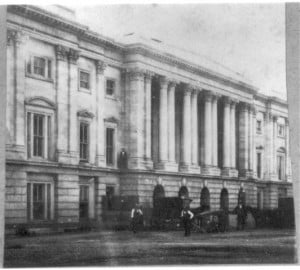New president, new flag
By James Breig
In three months, Americans will mark the 150th anniversary of the Battle of Gettysburg during the Civil War. A few months later, the sesquicentennial of the Gettysburg Address will be noted. Those two occasions have led to recent postings here about Abraham Lincoln and flags.
Those stories focused on his 1861 rail journey from Illinois to Washington, D.C., for his first inauguration. Once he was formally installed, Lincoln continued to make news concerning the American flag. On May 22, for instance, Lincoln went to the General Post Office Building in Washington to hoist a flag above it.

“I suppose that extended remarks are not expected of me at this time,” he said, “but that it is desired by all that we shall proceed at once to the work in hand — of raising our glorious national ensign to the proud and lofty eminence from which it [will] wave.”
A newspaper recorded that, “amid the most deafening applause from the crowd,” Lincoln grasped the halyards and elevated the flag to the top of the postal building.
“There being but a slight breeze at the time of its reaching its place at the top of the staff,” the journalist noted, the flag “remained for a moment or two motionless, when suddenly, [with] a gentle wind rising from the North, its ample folds were extended to the breeze in a most graceful and beautiful manner, eliciting one universal outburst of applause from the assembled multitude.”
The symbolism of a breeze coming from the North was not lost on the audience at the beginning of the Civil War — or on the president.
“I had not thought to say a word,” Lincoln said, “but it has occurred to me that a few weeks ago [when Fort Sumter was attacked] the Stars and Stripes hung rather languidly about the staff all over the nation. So, too, with this flag, when it was elevated to its place….But the glorious breeze came, and it now floats as it should. And we hope that the same breeze is swelling the glorious flag throughout the whole nation!”
